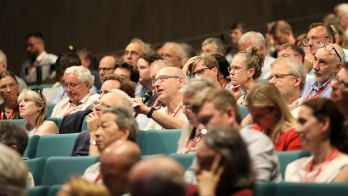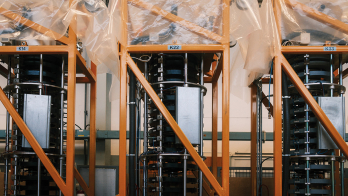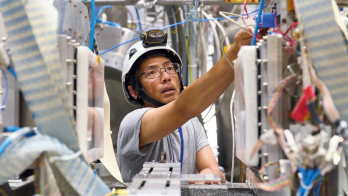Earlier this year 14 Nobel laureates wrote to the president of the CERN Council to encourage the member states to support some non-LHC research and R&D on future detectors and accelerators. Here we print their letter and the reply from the president of Council, Maurice Bourquin, and the director-general of CERN, Luciano Maiani.
Dear Professor Bourquin,
The European laboratory for particle physics, CERN, is often cited as the jewel of international collaboration. Created almost half a century ago by a consortium of 11 governments, CERN is now the world’s largest research laboratory, with 20 member states and significant support and collaboration from many other nations. Its scientific accomplishments are legion. CERN has been the worldwide leader in elementary-particle research for decades past and, hopefully, it will continue to be for decades to come.
The research carried out at CERN by its member states is “pure” in the sense of being guided primarily by the drive to understand the universe in which we live. It is an established fact that the practical consequences of even the most apparently exotic research have always been plentiful and unexpected: the Web, born at CERN, is only one example.
CERN is now embarked on an ambitious and fascinating endeavour: the construction of the Large Hadron Collider (LHC) and the deployment of large detectors to exploit it. Scientists within and outside the discipline of particle physics agree on the necessity for the timely completion of this promising project.
A series of circumstances has led its governing Council to require that all of CERN’s efforts, resources and manpower be focused on the LHC. While this may have become unavoidable, we wish to point out that such measures will be extremely damaging to the long-term future of the laboratory.
The scope of research now being done at CERN, as well as R&D for future CERN projects not related to the LHC, has already been reduced to a bare minimum. The moratorium on most lines of research will virtually terminate the training of the next generations of high-energy physicists. The severe cuts on R&D will have similar consequences for the training of accelerator and detector scientists, engineers and technicians. Moreover, with the absence of sufficient current long-term investments, there will be no further endeavours, CERN will have no post-LHC future, and its member states will have lost their leadership role in one of the most fundamental sciences. The CERN experience is not something that can be restarted “at the turn of a key”.
To remedy this situation, we would suggest that a small percentage of the CERN budget be earmarked for continued and renewed non-LHC research and for further R&D on future detectors and accelerators. We suggest that an appropriate ad hoc committee be constituted to study this proposal in detail. A modest effort of this kind would restore the enthusiastic morale once shared by all CERN personnel and users engaged in the quest for new knowledge; would preserve and transmit to future generations the carefully honed art and know-how underlying our discipline; and would enable CERN to continue to contribute to a better Europe and a better world.
We encourage the governments of the member states of CERN to weigh the present restrictive measures against a relatively small effort that would have an enormous impact upon the present and future research accomplishments at CERN, with considerable benefits to both science and society.
Sincerely,
Georges Charpak, Val L Fitch, Sheldon L Glashow, Gerard ‘t Hooft, Leon Lederman, Tsung-Dao Lee, Martin L Perl, Norman F Ramsey, Burton Richter, Carlo Rubbia, Martinus J G Veltman, Jack Steinberger, Steven Weinberg and Chen Ning Yang.
cc. Professors Aymar and Maiani, the members of Council and the members of the Scientific Policy Committee.
Maurice Bourquin and Luciano Maiani reply:
We feel very honoured that such a distinguished panel of scientists thinks so highly of the organization and of its achievements and shows concern about its future.
CERN was forced to make painful choices at the end of 2001, when the organization was confronted with a funding shortfall for the completion of the LHC project. In line with the recommendations of the External Review Committee, CERN management submitted a long-term plan, in June 2002, aimed at focusing resources and manpower on the LHC machine and experiments. The target of commissioning the machine in April 2007 was confirmed. The plan was finally accepted by Council in December 2002, and it puts the LHC construction on a firm, if very tight, basis.
The LHC is the worldwide priority in high-energy physics. The reduction in the scientific activities at CERN during the LHC construction was the price to pay for the future possession of this powerful tool.
A limited number of ring-fenced parallel activities have been maintained, however, to keep a minimum of scientific diversity (COMPASS, long base-line neutrino beam, low-energy antiprotons, low-energy nuclear and neutron physics) or to preserve vital options for CERN’s future (CLIC and its test facility and the design of the front-end of the Superconducting Proton Linac).
While submitting to Council the strategic decisions that have been adopted at the end of 2002, CERN management and several delegations pleaded with Council to consider providing additional resources to ensure an extension of CERN’s scientific activities, once the LHC financial situation was consolidated.
We welcome the recommendations made by the authoritative panel of Nobel laureates and we are sure they will help in opening a new fruitful discussion with the member states on the future of CERN and of international research in particle physics.








